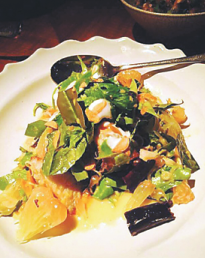Award-winning restaurant makes the most of Thai flavors
Updated: 2015-12-29 07:49
By Liu Zhihua(China Daily)
|
||||||||
|
 |
|
Kingfish salad with pomelo.[Photo by Liu Zhihua/ China Daily] |
The foods, presented separately in small amounts for diners to take from the same plate, arrived one by one. I was told the dishes arrived in order of increasing flavor intensity, gradually stimulating our taste buds to prepare our palates for spicier and sour delicacies to come.
Our first appetizer, maho, was small slices of pineapple topped with pork, nuts, palm sugar, coriander and other spices. The dish tasted mildly sweet and sour, but the ingredients had been so cleverly melded that it was hard to detect them individually amid the maho's crunchy and sticky texture.
Another starter, the blue swimmer crab with ginger canape, had a beautiful contrast between salty meaty crab and crunchy fried rice, and the red petal-like herb leaves on top added a refreshing touch to the dish.
Tom yum kung and curry crab (coconut and tumeric crab curry) are perhaps the most common Thai dishes, served at virtually every Thai eatery in China. But those I had in Nahm were among the best I have ever had - the ingredients so fresh that I could detect slight sweetness in the crustaceans, even through the seasonings' flavors.
The clear soup of roast duck was also very savory, having a bit of sweetness offsetting the rich taste and aroma of basil and coconut.
I also liked the steamed coral trout, a tender and meaty fish.
The desserts were innovative and tasty, with various tropical fruits as ingredients. I liked durian rice the most. A little salted, the durian rice was delicately balanced between sweetness and saltiness - a perfect ending to our dinner.

 Yearender: Key words from popular China news stories in 2015
Yearender: Key words from popular China news stories in 2015
 Hangzhou shuts steel plant to improve air quality
Hangzhou shuts steel plant to improve air quality
 Yearender 2015: Chinese athletes of year
Yearender 2015: Chinese athletes of year
 China's longest tunnel under lake open to traffic
China's longest tunnel under lake open to traffic
 Top 10 policy changes in China in 2015
Top 10 policy changes in China in 2015
 Yearender 2015: Natural disasters
Yearender 2015: Natural disasters
 The world in photos: Dec 21 - 27
The world in photos: Dec 21 - 27
 Yearender: Film critics' top 10 Chinese films of 2015
Yearender: Film critics' top 10 Chinese films of 2015
Most Viewed
Editor's Picks

|

|

|

|

|

|
Today's Top News
Shooting rampage at US social services agency leaves 14 dead
Chinese bargain hunters are changing the retail game
Chinese president arrives in Turkey for G20 summit
Islamic State claims responsibility for Paris attacks
Obama, Netanyahu at White House seek to mend US-Israel ties
China, not Canada, is top US trade partner
Tu first Chinese to win Nobel Prize in Medicine
Huntsman says Sino-US relationship needs common goals
US Weekly

|

|








